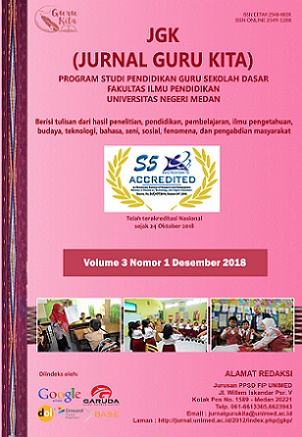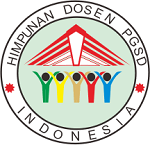PENGARUH MODEL PEMBELAJARAN SYNETICS PADA SISWA SD DALAM MENINGKATKAN HASIL BELAJAR DAN KEMAMPUAN BERFIKIR KREATIF
DOI:
https://doi.org/10.24114/jgk.v3i4.15273Abstract
Abstract: The Effect of Synetics Learning Model on Elementary Students in Improving Learning Outcomes and Creative Thinking Ability. This study aims to show; (1) a significant influence between the cynetics learning model on Thematic learning outcomes in students in grade V SD., (2) a significant effect of the relationship between learning outcomes and the ability to think creatively. This research is a qualitative and quantitative research with a quasi-experimental method. This study uses instruments consisting of treatment instruments and measurement instruments. A sample of 64 students consisted of 32 experimental class students and 32 control class students. Student learning outcomes data is taken through the test method and analyzed using descriptive statistics and inferential statistics, in this case the data analysis technique is using t-test. Analysis of the relationship of learning outcomes to critical thinking skills used data analysis techniques is correlation. Data on creative thinking ability is done by using a questionnaire. The results showed that; (1) there is a significant influence between the cynetics learning model on Thematic learning outcomes in students in grade V elementary school, (2) there is a significant influence on the relationship between learning outcomes and the ability to think creatively.Keywords: Synectics, Creative Thinking, Learning OutcomesAbstrak: Pengaruh Model Pembelajaran Synetics Pada Siswa SD dalam Meningkatkan Hasil Belajar dan Kemampuan Berfikir Kreatif. Penelitian ini bertujuan untuk menunjukkan; (1) pengaruh yang signifikan antara model pembelajaran cynetics terhadap hasil belajar Tematik pada siswa di kelas V SD., (2) pengaruh yang signifikan hubungan antara hasil belajar dengan kemampuan berfikir kreatif. Penelitian ini adalah penelitian kualitatif dan kuantitatif dengan metode quasi eksperimen. Penelitian ini menggunakan instrumen yang terdiri dari instrumen perlakuan dan instrumen pengukuran. Sampel sebanyak 64 siswa yang terdiri dari 32 siswa kelas eksperimen dan 32 siswa kelas kontrol. Data hasil belajar siswa di ambil melalui metode tes dan dianalisis dengan menggunakan statistik deskriptif dan statistik inferensial, dalam hal ini teknik analisis datanya adalah menggunakan uji-t. Analisis hubungan hasil belajar terhadap kemampuan berfikir kritis digunakan teknik analisis datanya adalah korelasi. Data kemampuan berfikir kreatif dilakukan dengan menggunakan angket. Hasil penelitian menunjukkan bahwa; (1) terdapat pengaruh yang signifikan antara model pembelajaran cynetics terhadap hasil belajar Tematik pada siswa di kelas V SD., (2) terdapat pengaruh yang signifikan hubungan antara hasil belajar dengan kemampuan berfikir kreatif.Kata Kunci: Synectics, Berfikir Kreatif, Hasil BelajarDownloads
Published
2019-09-20
How to Cite
Sitompul, H. S., Br Ginting, Y. F., & Tarigan, S. W. (2019). PENGARUH MODEL PEMBELAJARAN SYNETICS PADA SISWA SD DALAM MENINGKATKAN HASIL BELAJAR DAN KEMAMPUAN BERFIKIR KREATIF. JGK (Jurnal Guru Kita), 3(4), 378–386. https://doi.org/10.24114/jgk.v3i4.15273
Issue
Section
Articles
License
Authors published with the JGK (Jurnal Guru Kita) agree to the following terms:
- Authors retain copyright and grant the journal the right of first publication with the work simultaneously licensed under a Creative Commons Attribution License (CC BY-SA 4.0) that allows others to share the work with an acknowledgment of the work's authorship and initial publication in this journal.
- Authors are able to enter into separate, additional contractual arrangements for the non-exclusive distribution of the journal's published version of the work (e.g., post it to an institutional repository or publish it in a book), with an acknowledgment of its initial publication in this journal.
- Authors are permitted and encouraged to post their work online (e.g., in institutional repositories or on their website) prior to and during the submission process, as it can lead to productive exchanges, as well as earlier and greater citation of published work. (See The Effect of Open Access)













